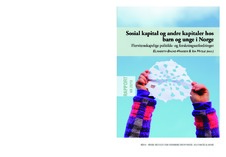| dc.contributor.author | Backe-Hansen, Elisabeth | |
| dc.contributor.author | Hydle, Ida Marie | |
| dc.date.accessioned | 2020-06-07T21:05:38Z | |
| dc.date.accessioned | 2021-04-29T13:49:38Z | |
| dc.date.available | 2020-06-07T21:05:38Z | |
| dc.date.available | 2021-04-29T13:49:38Z | |
| dc.date.issued | 2010 | |
| dc.identifier.isbn | 978-82-7894-360-1 | |
| dc.identifier.issn | 0808-5013 | |
| dc.identifier.uri | https://hdl.handle.net/20.500.12199/3324 | |
| dc.description.abstract | Is the concept of «social capital» useful to social scientific research concerning children and young people? Is it useful for the development of social policies? The report adresses these questions through a comprehensive literature review combined with discussions of research done by the contributors. At a youth research conference in 2008 the British youth researcher Janet Holland showed that «social capital» is often criticized for serving as a rubber sheet concept which is stretched in all directions to accomodate any issue we wish to focus on. A more concise meaning of the concept has still not been established. At the same time, however, the concept may serve as an aid to developing new analytical dimensions and new research questions, as well as adding new political questions to the agenda. Consequently we need an ongoing conceptual clarification, and it may well be that the most important mission of the concept is to raise the following question: «What kind of social relations serve actor X best in situation Y in order to achieve goal Z”? In the report we argue that the answer to this question is too context-dependent to enable a generalized undestanding of what kinds of social relations that constitute social capital across actors, goals, and situations. Through the literature review and discussions of the contributors’ own research we show in what ways «social capital» may be concretized and made more precise. In the first part of the report we present a knowledge status covering relevant Norwegian and international research, in particular concerning the areas of generation, school, delinquency and locality. In addition we have included research on children and young peoples’ welfare in a wide sense such as health, well-being, access to resources outside the family and participation in civil society. An important issue discussed here is to what extent researchers portray children and young people as active in creating and maintaining social capital. We have also reviewed literature directly using social capital as an analytical tool. In addition we have reviewed literature about phenomena that are often interpreted as social capital, like trust, social networks and participation in civil society. Since research literature about children and young people is prolific it was necessary to choose some functional inclusion criteria. We discuss what social capital may be understood as – and used for – with important contributions to the literature from our view as a point of departure. In addition we have developed some new concepts, like what we call sub-cultural capital and liminal capital. This serves as the basis for further clarification and interpretation of the concept, through discussions of how marginalized persons or persons on the borderline of society can have their own forms of social capital. The first part of the report focuses primarily on relevant research areas. We identify comparative as well as national projects, and projects utilizing quantitative as well as qualitative methodologies. We argue that social capital can be seen as processes that can be incluenced by political initiatives as well as through how institutions and professionals act. We also argue that research on social capital will not only result in new knowledge, but also lead to knowledge about children, young people and their families that is relevant for the practice field. In the second and third parts of the report we also discuss relevant literature as well as themes and issues for further research (perspectives, themes, and methodologies). We demonstrate the relevance of subcultural or liminal capital as concepts through analyses of two empirical studies. First, these studies underline that this perspective on social capital among marginalized groups helps us see resources and not only problems among thesegroups of young people. Second, the studies open up for a discussion of possibilities for a more dynamic understanding of the concept of social capital. Since this constitutes an extension of a concept that is already criticized for being far too comprehensive and vague, it remains to be seen whether this is an advantage or a disadvantage with regard to our thinking about social capital. | en |
| dc.description.abstract | Er begrepet sosial kapital nyttig for samfunnsvitenskapelig forskning og politikkutviklingen for og med barn og unge? Denne NOVA-rapporten svarer ved hjelp av litteraturgjennomgang og egen forskning. Begrepet sosial kapital kan bidra til nye forståelser og spørsmål og er kontekstavhengig av aktører, mål og situasjoner. Vi har vektlagt generasjoner, skole, kriminalitet, nærmiljø, helse, trivsel, tilgang til ressurser utenom familien og deltagelse - og forskningslitteraturens fremstilling av barn og unge som aktive i å skape og opprettholde sosial kapital. Vi utvikler nye begreper i forlengelsen av dette, subkulturell og liminal kapital, for å klargjøre ulike betydninger. Marginaliserte personer som beveger seg på grensene, de liminale, kan ha sin egen form for sosial kapital. Forskningen om sosial kapital kan få fram ny, handlingsrelevant kunnskap om barn, unge og familier. | no_NB |
| dc.publisher | Oslo Metropolitan University - OsloMet: NOVA | |
| dc.relation.ispartofseries | NOVA Rapport 20/10 | |
| dc.subject | NOVA | |
| dc.title | Sosial kapital og andre kapitaler hos barn og unge i Norge | no_NB |
| dc.type | Report | |
| fagarkivet.author.link | https://www.oslomet.no/om/ansatt/idahy | |
| fagarkivet.source.pagenumber | 225 | |
